

 |
 |
Expedition through the Upper Mississippiby Henry Rowe Schoolcraft |
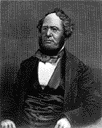 |
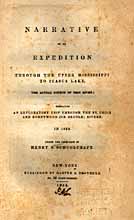 |
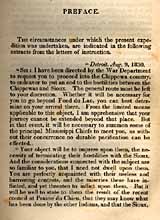 |
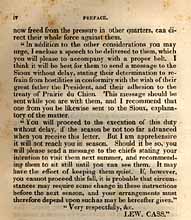 |
Character of the St. Croix.--Its productiveness in wild rice.--Population and trade.--Condition
of the Indians, and their prospect.--Portage to the Burntwood.--Marine sand formation.--Bass
lake.--Character of the Burntwood river.--Arrival at its discharge into Fond du Lac of Lake
Superior.--Indian friends.--Close of the Narrative.--Brief general remarks on the condition
of the Chippewas.--Traits of character and government.--The institution of the Totem.--Tale
of the origin of White Fish.
|
ON entering lake St. Croix we were favored with a fair wind, and made use of our sails in passing it. As we approached its head, we found the swell formidable, but were able, nevertheless, to keep the lake. We debarked, on a marshy margin at its head, being the commencement of the portage to the Brulé. As the river St. Croix has its origin here, a few general remarks on its geographical features may be subjoined.--This stream is an important tributary to the Upper Mississippi, originating on elevated grounds, and consequently, having a rapid mean descent. Although not remarkable for its length, its waters spread in a lateral line, an unusual distance. It has many tributaries, connecting it, on the north, with Rum river, on the south, with Chippewa river, and towards the east with the Mauvais and the Brulé rivers of Lake Superior. The main channel may be estimated, by its windings, at two hundred miles. The length of its Namakagon fork, is estimated to be one hundred and seventy miles, while that of its northern branch does not probably exceed sixty-five miles. Both branches, together with its lower tributaries, and their numerous lakes, yield the northern rice plant. The abundance of the plant, has led to the local term of the Follo Avoine country, a name by which it is particularly known in the transactions of the Fur Trade. |
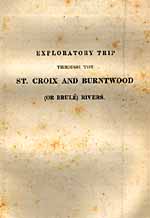 |
|
It has a comparatively mild climate, and rich soil, and in addition to the small fur bearing animals, on the sale of which the Indians rely for their woollens, arms, and ammunition; it affords the spontaneous means of subsistence, more fully, perhaps than most other parts of the northwest regions. Its present aggregate population has been estimated the present year, at eight hundred and ninety-five, say nine hundred souls, numbering those only who are permanently located in its valley.--What quantity of furs and peltries is annually got from it, and what amount of Indian goods are required to pay for them, are questions which might be ascertained, with general accuracy, by consulting official records. But it is sufficient for the purposes of moral enquiry, to remark, that both the supplies and the returns, are less than they were in former years, and that there is a declension in the trade, which must at length produce a migration of the Indians, or induce them to become agriculturists. The fate that has overtaken other tribes, enjoying a more southerly position, must inevitably overtake these bands. And the period will probably arrive earlier, than it might be anticipated. They occupy a portion of the Mississippi valley, which is adapted for agriculture. Many parts of it, possess a rich soil, and are well timbered. Other portions are prairie land, suited for pasturage. Its most arid tracts abound in pine, and there is hardly a stream, of its many tributaries which does not afford numerous eligible seats for saw and grist mills. Hunting seems the only occupation, which cannot be a permanent one. But, "While thus the chase declines, and herds depart, The portage from the St. Croix to the Burntwood, begins at the head of (the Upper) lake St. Croix. It lies over an elevated sandy pine ridge, which divides the two streams. The distance which the canoes and packages require to be carried, is 3,350 yards, or nearly two miles. On the left hand, in carrying from the St. Croix, there is a deep tamerac valley, which is said to afford the head springs of both streams. On the right, is seen, at some distance, a small lake, which is stated to yield the black bass, and to have no outlet. Its existence in a sand formation, indicates perhaps, coral rag, hardpan or some firmer material below. This sand is apparently of marine deposition and agrees, in this respect, with the extensive formations at the sources of the Mississippi. |
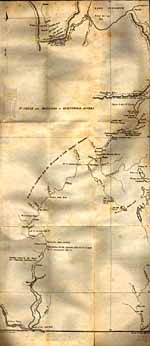 St Croix River Map |
|
The goods after being carried this distance, are put down, on the banks of a sandy bottomed brook of very clear cold water, overhung with alders. Any other person, but one who had become familiar with northwest portages, would be apt to say, on being ushered to this secluded spot, "well, this is certainly an eligible spot to quench one's thirst at, but as for embarking on this rill, with a canoe and baggage, the thing seems to be preposterous." And so it certainly appeared, on our arrival.--There was not an average depth of water of more than two to four inches. But by going some distance below, and damming the stream, it rose in a short time, high enough to float a canoe, with a part of its lading. The men walking in the stream, then led the canoes, cutting away the brush to veer them, and carrying such parts of the lading as could not, from time to time, be embarked. We did not begin the descent, till six o'clock, in the evening, and went about a mile during the first hour and a half. It then became so dark, that it was necessary to encamp. And to encamp in such a place, seemed impossible. We could not, however, hesitate. There was no alternative, we could neither advance nor recede, and we were surrounded with a shaking bog. We slept on a kind of bog, which the men, call tetes des femmes. Some rain fell during the night, but we were happily relieved from the fear of inundation, by the showers passing off. The next morning brought with it, a resumption of the toil of the evening. The canoes were sent on entirely empty. All the baggage was carried about a mile, at which distance the stream is perhaps doubled in width, and more than doubled in depth. The next mile rendering the going quite easy. At this point, say three miles from the portage, we embarked all our baggage, and after this, found no want of water, till we came to the rapids. These, commence about twenty-four miles below the portage, and they extend with intervals of smooth water, "few and far between," to within three or four miles of the point of the entrance of the river, into Lake Superior. The entire length of this river may be estimated at one hundred miles, more than eighty miles of this distance consists of rapids. It has been said that there are two hundred and forty distinct rapids. At most of these, there is several feet fall. At some of them eight to ten feet. Four of them require portages of short extent. Six or seven hundred feet would not appear to be an extravagant estimate for the entire fall. The river itself is a perfect torrent; often on looking down its channel, there are wreaths of foam constituting a brilliant vista, overhung with foliage. It would never be used at all, for the purposes of the trade, were it not, that there is much water on the rapids, so that experienced men can conduct loaded canoes both up and down them. The river might appropriately be called Rapid, or Mad River, or almost any thing else, but by its popular name of Brulé. This is, in fact, rather a departure than a derivative from the Indian, Wisákoda, i. e. burnt-pines, or burnt-wood in allusion to a signal destruction of pine forest by fire. We were two days, and part of an evening, in effecting the descent and regained our outward track, at the point of its discharge into the Fond du Lac of lake Superior. We reached this point on the fourth of August, late at night, having gone later than usual, from the fact of finding ourselves below the rapids, and consequently knowing that we must be near the lake. Our first certain indication of our proximity to it, was, however, given by hearing the monotonous thump of an Indian drum. We soon after came in sight of camp fires, with Indian forms passing before them.--And we found ourselves, on landing, in the midst of former Indian acquaintances. Among them were Mongazid (Loon's Foot,) the second Chief of Fond du Lac, and Chamees, (Pouncing Hawk,) a young man who had first recommended himself to notice in 1820, by guiding a part of Governor Cass' expedition above the Knife Portage, and who evinced the same disposition, during the forepart of the present summer, by acting as a guide to the party, between Fond du Lac and Sandy Lake. We were pleased on observing the military boat, used by Lieutenant Allen on the lake, safely moored, with its sails and tackle, within the mouth of the river, having been brought down, agreeably to promise, by Mongazid, who had faithfully remained in charge of it. |
 Brulé River |
|
The day following, being the Sabbath, was spent at this place. And the narrative of our route from the Mississippi may here be appropriately closed. Some remarks arising from observations on the condition of the Indians, among whom we have passed, it may be proper to add; but from the little leisure we can command, they are necessarily few and brief. The Chippewas are spread over a very large area in the north, divided into local bands, and separated by extensive tracts which are, in great part, sterile. They are not fixed in their habitations at any point, during the whole of the year, being compelled to go in search of the game, fish, and other spontaneous productions, on which they depend. The space which each band periodically traverses, in this effort is extensive, and subjects them to casualties, which they would otherwise escape. Their condition is still further imbittered by hostilities with the Sioux tribes, who occupy the whole line of their western frontier. They cover the entire northwestern angle of the United States, extending down the Mississippi valley on both banks, as low as the Wadub, being the first stream above Sac river. At this point their territorial line crosses from the west to the east banks of the Mississippi, pursuing a southerly course, at the distance of about forty miles from it, until it intersects the lands of the Winnebagoes, north of the Wisconsin. This portion of the territory affords decidedly the largest and best body of farming lands in their possession, and will, probably, hereafter yield them, either by the proceeds of its sale, or cultivation, a more sure reliance at a period when the land becomes divested of game. The climate of this area is comparatively mild, and the Indians who inhabit it, notwithstanding their partial losses from wars, have evidently increased in population. They might be concentrated here, could the agricultural be substituted for the hunter life--a result which may be expected to follow, but cannot in any reasonable estimate be expected to precede, their conversion to christianity. |
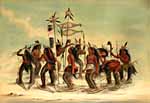 Snowshoe Dance |
|
This tribe offer no prominent obstacles to the introduction of the gospel. We have before adverted to the slender frame work of their native religion, which seems to be made up, primarily of certain superstitious ceremonies, winding themselves about the subject of medicine. It appears to occupy that void in the barbaric mind, which the soothsayers and magii of other lands, pressed forward, in the absence of revelation, to fill. But we do not know that the ritual has any striking features in common. The principal obstacle which missionaries will have to contend with, is a want of the knowledge of their language. And to surmount this is a labor which they cannot too early begin nor too zealously persevere in. The language itself, as we have before indicated, (vide Chap. X.) presents a copious vocabulary, and is capable of being made the medium of religious instruction. It has some defects which will require to be supplied, and some redundancies which will demand curtailment, when it comes to be written. But they offer very slight obstacles to oral communication. It is obviously better suited to convey narrative than disquisitive matter. And has been so long applied to corporeal objects, that It requires caution and a familiar knowledge of its idioms, in the conveyance of intellectual and still more of spiritual conceptions. In mere externals, the Chippewas are not essentially different from other tribes of the Algonquin stock in the western country. And the points in which a difference holds, may be supposed to have been, for the most part, the effects of a more ungenial climate. They are, to a less extent than most of the tribes, cultivators of the soil, and more exclusively hunters and warriors. Living in a portion of the continent, remarkable for the number of its large and small lakes, they find a common resource in fish, and along with this, enjoy the advantage of reaping the wild rice. Their government has been deemed a paradox, at the same time exercising, and too feeble to exercise power. But it is not more paradoxical than all patriarchial governments, which have their tie in filial affection, and owe their weakness to versatility of opinion. War and other public calamities bring them together, while prosperity drives them apart. They rally on public danger, with wonderful facility, and they disperse with equal quickness. All their efforts are of the partizan, popular kind. And if these do not succeed they are dispirited. There is nothing in their institutions and resources suited for long continued, steady exertion. The most striking trait in their moral history is the institution of the Totem--a sign manual, by which the affiliation of families is traced, agreeing, more exactly, perhaps, than has been supposed, with the armorial bearings of the feudal ages. And this institution is kept up, with a feeling of importance, which it is difficult to account for. An Indian, as is well known, will tell his specific name with great reluctance, but his generic or family name--in other words, his Totem, he will declare without hesitation, and with an evident feeling of pride. None of our tribes have proceeded farther than the first rude steps in hieroglyphic writing And it is a practice in which the Chippewas are peculiarly expert. No part of their country can be visited without bringing this trait into prominent notice. Every path has its blazed and figured trees, conveying intelligence to all who pass, for all can read and understand these signs. They are taught to the young as carefully as our alphabet, with the distinction, however, that hieroglyphic writing, is the prerogative of the males. These devices are often traced on sheets of birch bark attached to poles. They are traced on war-clubs, on canoe paddles, bows or gun stocks. They are often drawn on skins, particularly those used as back dresses, by warriors. They have also other hieroglyphic modes of communicating information, by poles with knots of grass attached to them, or rings of paint, and often by antlers, or animals' heads suspended by the banks of rivers. The following tale is added as an example of the kind of imaginative lore indicated by it. ORIGIN OF THE WHITE-FISH.In ancient times when the Indians were better than they now are, when their laws were enforced by the chiefs, and when every crime was promptly punished, there lived a noted hunter and a just man, at a remote point on the north shore of Lake Superior. He had a wife and two sons, who were usually left in the lodge, while he went out in quest of the animals upon whose flesh they subsisted. As game was then abundant, his exertions were well rewarded, and he lived in the enjoyment of every blessing. But there was at this time a venom preparing for his heart, which was not the less poisonous because it was for a time kept in secret. His two little sons had observed the visits of a neighboring hunter, during the absence of their father, and they ventured to remonstrate with their mother on the propriety of receiving clandestine visits, but she was in no temper to be reasoned with. She rebuked them sharply, and finally, on their intimation of disclosing the secret, threatened to kill them if they made any disclosure. They were frightened into silence. But observing the continuance of an improper intercourse, kept up by stealth as it were, they resolved at last to disclose the whole matter to their father. The result was such as might be anticipated. The father being satisfied with the infidelity of his wife, took up a war club at a moment when he was not perceived, and with a single blow despatched the object of his jealousy. He then buried her under the ashes of his fire, took down his lodge, and removed to a distant position. But the spirit of the woman haunted the children who were now grown up to the estate of young men. She appeared to them in the shadows of evening. She terrified them in dreams. She harrassed their imaginations wherever they went, so that their life was a life of perpetual terrors. They resolved to leave the country, and commenced a journey of many days towards the south. They at length came to the Poiwateeg falls. (St. Mary's.) But they had no sooner come in sight of these falls, than they beheld the skull of the woman (their mother) rolling along the beach after them. They were in the utmost fear, and knew not what to do, to elude her, when one of them observed a large crane sitting on a rock in the rapids. They called out to the bird. "See, Grandfather, we are persecuted by a spirit. Come and take us across the falls so that we may escape her." This crane was a bird of extraordinary size and great age. And when first descried by the two sons, sat in a state of stupor, in the midst of the most violent eddies of the foaming water. When he heard himself addressed, he stretched forth his neck, with great deliberation, and then raising himself on his wings flew across to their assistance. "Be careful" said the crane, "that you do not touch the back part of my head. It is sore, and should you press against it, I shall not be able to avoid throwing you both into the rapids." They were, however, attentive on this point, and were both safely landed on the south side of the river. The crane then resumed its former position in the rapids. But the skull now cried out. "Come Grandfather and carry me over, for I have lost my children, and am sorely distressed." The aged bird flew to her assistance, but carefully repeated his injunction, that she must by no means touch the back part of his head, which had been hurt, and was not yet healed. She promised to obey, but she soon felt a curiosity to know, where the head of her carrier had been hurt, and how so aged a bird could have acquired such a bad wound. She thought it strange, and before they were half way over the rapids, could not resist the inclination she felt to touch the affected part. Instantly the crane threw her into the rapids. The skull floated down from rock to rock, striking violently against their hard edges, until it was battered to fragments, and the sons were thus happily and effectually relieved from their tormentor. But the brains of the woman, when the skull was dashed against the rocks, fell into the water, in the form of small white roes, which soon assumed the shape of a novel kind of fish, possessing a whiteness of color peculiar to itself; and these rapids have ever since been well stocked with this new and delicious species of fish. The sons meantime took up their permanent abode at these Falls, becoming the progenitors of the present tribe, and in gratitude to their deliverer adopted the Crane* as their Totem. |
|
* The Crane is the totem of the reigning chiefs of the band of Sault Ste. Marie.